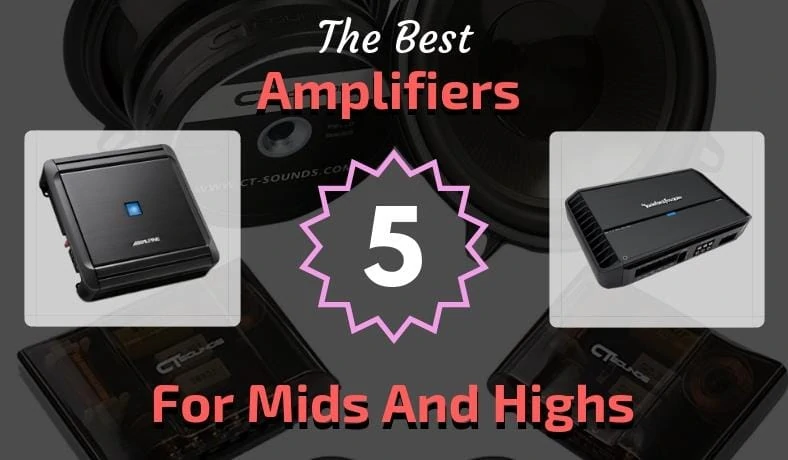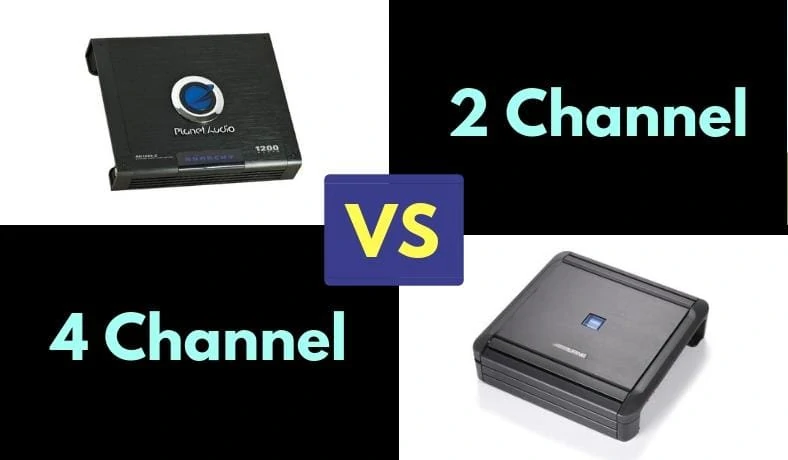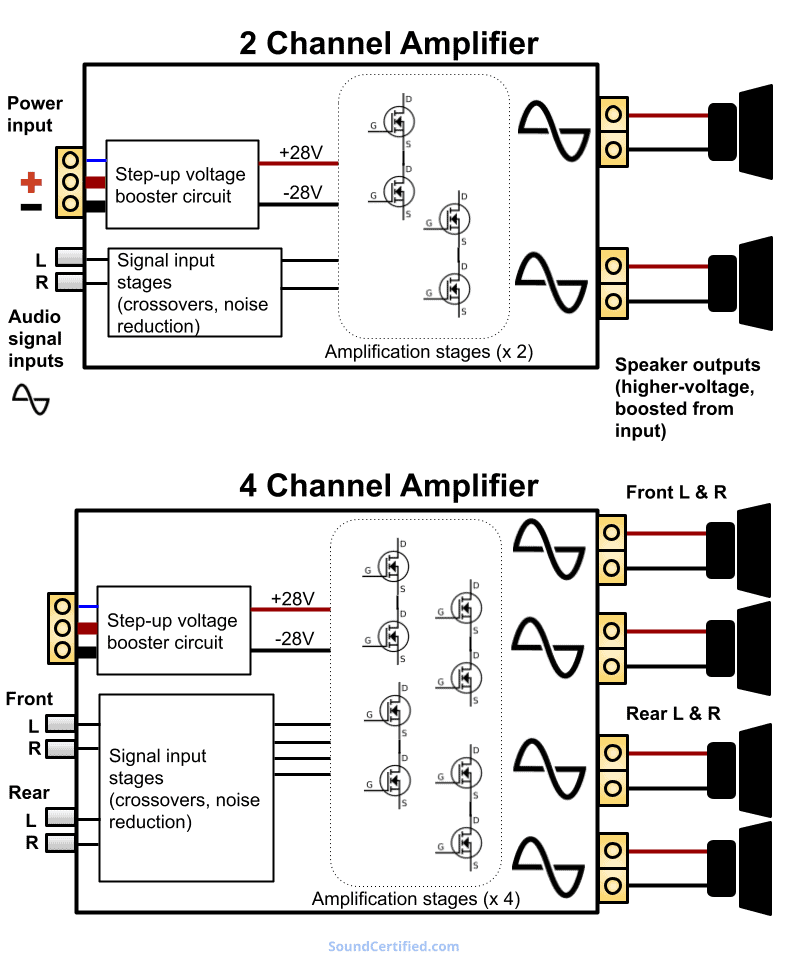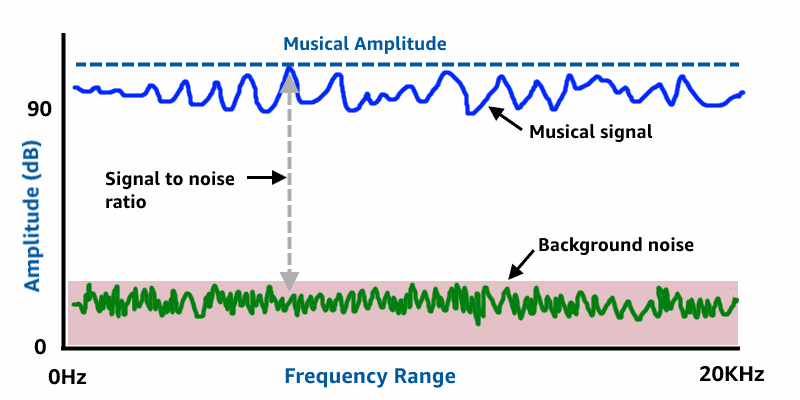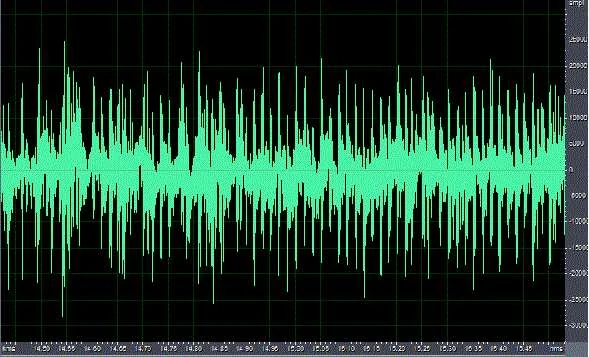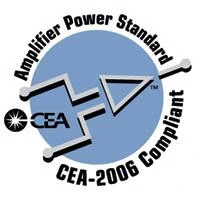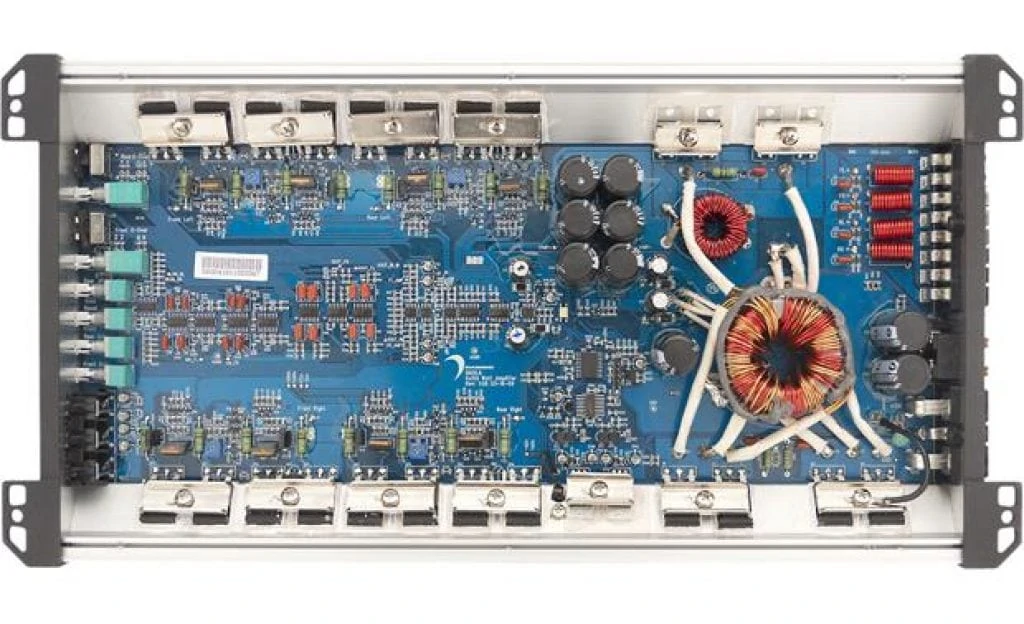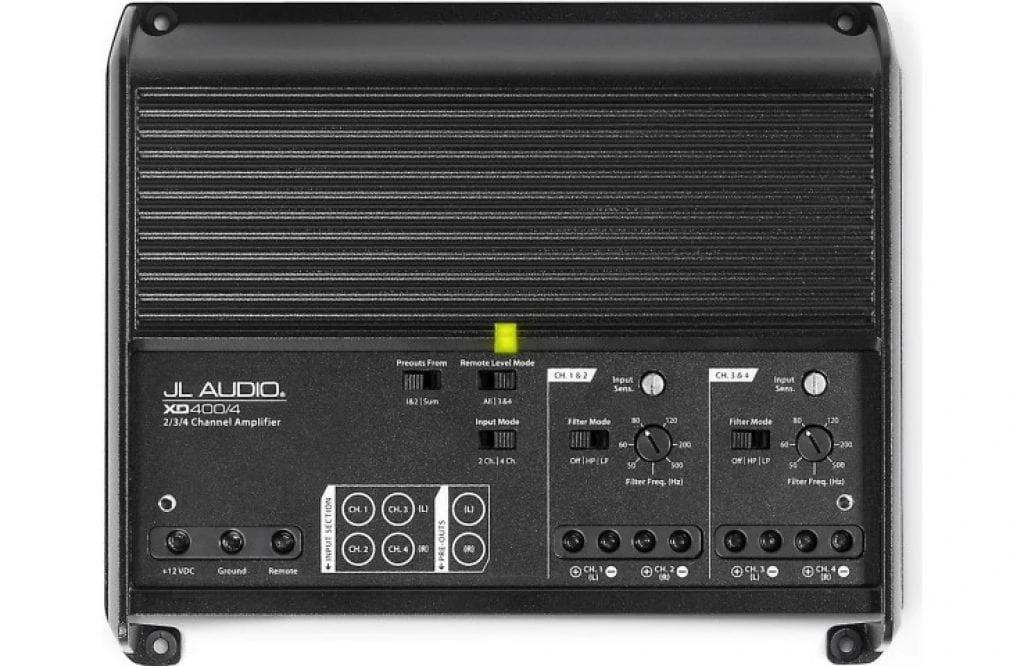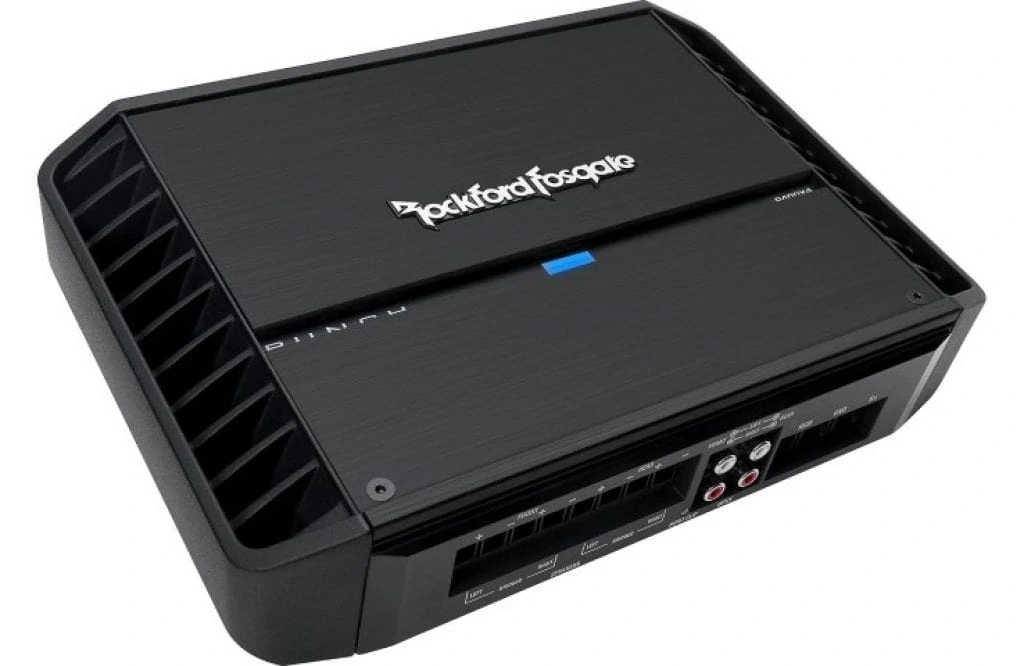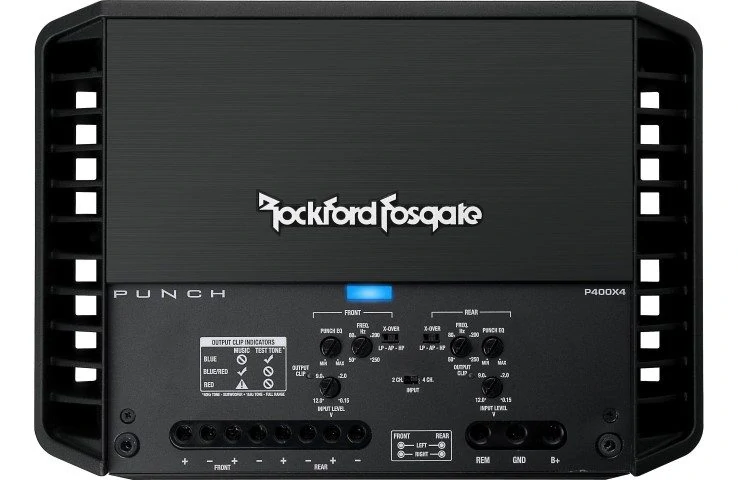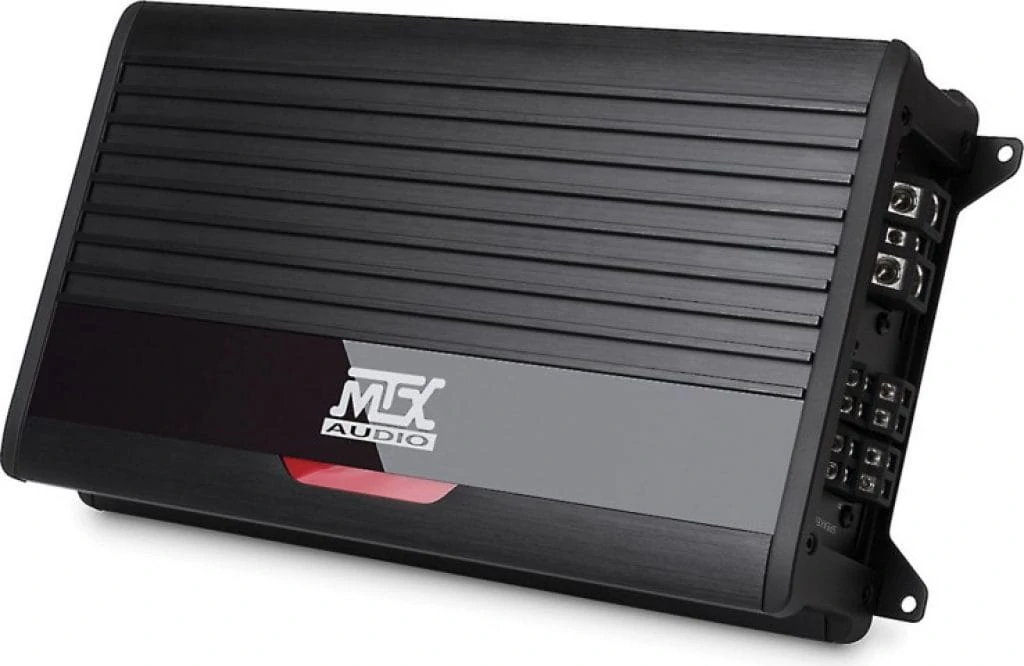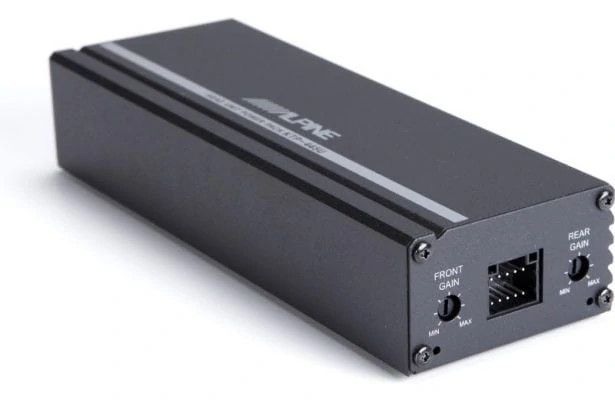Want a system with amazingly clear and impressive sound? Let’s be honest: driving highs and mids from a head unit is almost impossible!
That’s where an amp comes in – you’ll get great power, awesome volume, and fantastic sound clarity. However, you’ll have to pick a good amp that won’t let you down.
To help you get the best for your money I’ve put together a list of 5 of the best amps for mids and highs. Each has a short review and the specs you’ll need to know.
There’s also a helpful buyer’s guide included below. Read on to learn more!
Contents
2 channel vs 4 channel amps
As you might have already guessed, 4-channel amps are a bit different than others. There are a few differences to know about when shopping and just to have a better understanding.
The main difference is that 4 channel amps contain a 2nd pair of amplification stages to boost the input signal and drive speakers.
Just like standard 2-channel amps, they contain a special section that steps up a vehicle’s 12V supply to deliver a higher one (often around positive and negative 28 volts or so)
That’s necessary to provide sufficient power that can drive your component speakers or highs and mids at a better volume with low distortion. For example, car stereos can only use about 12V to drive speakers, resulting a lower power that distorts easily.
According to Ohms law more power requires a higher voltage and that’s exactly what powerful car amps are designed to use.
4 channel amps are also a bit more compact in size as the additional 2 channels take up a bit less space than 2 separate 2-channel amps used separately.
Different features
In order to work in more applications, some 4 channel amps feature a 2/4 channel input switch. This means that if you have a source unit with only 2 RCA jack outputs you can still get 4 channels of sound to use from the amp.
Additionally, most 4 channel amps sold today are bridgeable, meaning that each pair of channels can be used to drive a single speaker for more power than each individual channel can provide. Because of this, they offer more flexibility for custom car audio systems than a single 2-channel amplifier can.
Some also feature different options like a bass boost for the rear channels (normally #3 & 4). The specific features you’ll find vary from brand to brand and model to model.
2 channel vs 4 channel car amplifier diagram
A diagram I’ve provided illustrating the differences between 2 and 4 channel amplifiers. Both work exactly the same way: a +12V supply from the battery is boosted (“stepped up”) to create a higher positive and negative voltage supply. These voltages are then used to drive speaker outputs which are an amplified version of the input signals from your car stereo. Not that 4 channel amps are normally more compact than 2 separate 2-channel amps of the same type.
What to shop for in good quality car amps
For mids and highs, it’s ideal to focus a few basic factors when shopping:
- Sufficient power (in RMS watts)
- Sound quality and the signal-to-noise (SNR) specs
- Crossover controls
Basically, you’ll want an amp with good sound quality that can give a decent amount of power. For most applications, I recommend 50W RMS per channel minimum.
You’ll also want the ability to block distortion-causing bass by using high-pass crossovers on your tweeters or midrange speakers.
Signal to noise ratio
A signal-to-noise (SNR) measurement describes the ratio of the level of noise (undesired) to the desired musical signal. It’s measured in decibels (dB) and helps you to decide between a better product and a lower-performance product. Ideally the amount of noise compared to the signal level will be very small, represented as a larger number. For example, a SNR of 90dB and above is a good rule of thumb to look for. The noise I’m describing often appears a slight “hiss” when no music is playing and the amp’s gain is high.
Better amplifiers have a higher signal-to-noise (SNR) ratio. The SNR specification, measured in decibels (dB), is a standard amplifier measurement used to compare noise levels against others. It’s a ratio used to mathematically compare the level of noise that an amplifier’s electronics create vs the audio signal’s level.
As a general rule of thumb, the higher the SNR, the better. Amplifiers with great sound quality tend to have an SNR of 90dB and higher with some reaching above 100dB. That’s often found on more expensive and better-designed amplifiers.
It’s important to note, however, that unfortunately sometimes the specs are confusing. For example, at times some manufacturers exaggerate their amplifier specs or use the SNR value full power output, which is normally much higher.
Traditionally the most consistent measurement is by listing the SNR with no signal output and with 1 watt of power being driven.
Internal audio noise in an amplifier as viewed on a test instrument, enlarged. All amplifiers generate some internal noise…however the best models keep it at a minimum and are designed to produce good sound quality where noise is less noticeable.
When using tweeters (highs) and midrange or component speakers (mids), it’s often easier to hear the slight “hiss” an amp produces if the noise level isn’t very good.
Generally speaking, a well-designed amp will have this greatly reduced and this won’t be an issue. However, to keep noise from an amp down, it’s ideal to drive it with a good, strong signal from a head unit.
This way the amps gain level can be kept lower and noise output will won’t be noticeable.
Using crossovers with mids and highs
A good amp like the Alpine MRV-F300 will provide plenty of crossover options to not only protect your mids and highs but get the most out of them. By using high-pass crossovers, you can block the lower-end bass that they can’t handle and that causes distortion. The result is greatly clarity and much more volume!
Built-in crossovers in an amplifier are extremely helpful for getting excellent sound when using tweeters and midrange car speakers. The good news is that most, if not all, include them these days.
However, some are better than others in their flexibility and how they can benefit you.
How do crossovers work in a car amp?
Small speakers like midrange drivers or tweeters (for example, separately used or in a 2-way component system) aren’t designed to deliver heavy bass the way subwoofers can.
With only a low volume and a small amount of power, it may not be an issue. However, as soon as they’re driven to higher volume and with more power you’ll begin to hear distortion and the sound will “break up” quickly.
Crossovers work by using electronic filter sections to cut off, or filter out, the sound frequencies you want to prevent from reaching speakers.
For example, setting your amp’s high-pass option to 60Hz for driving mids will deliver a clean, nearly distortion-free sound at high volume.
Your options may vary
For mids and highs, always buy a model with crossovers built in. If you’re planning to drive woofers or subwoofers, be sure the model you’re considering has low-pass crossovers as well.
While some amps feature a fixed cutoff frequency of say 50Hz or so, some models offer adjustable controls which is even better. Adjustable crossovers allow you to better customize your system to your needs.
Additionally, products with a bass boost (or “EQ”) feature can help boost lacking bass in some cases.
Good amp design quality
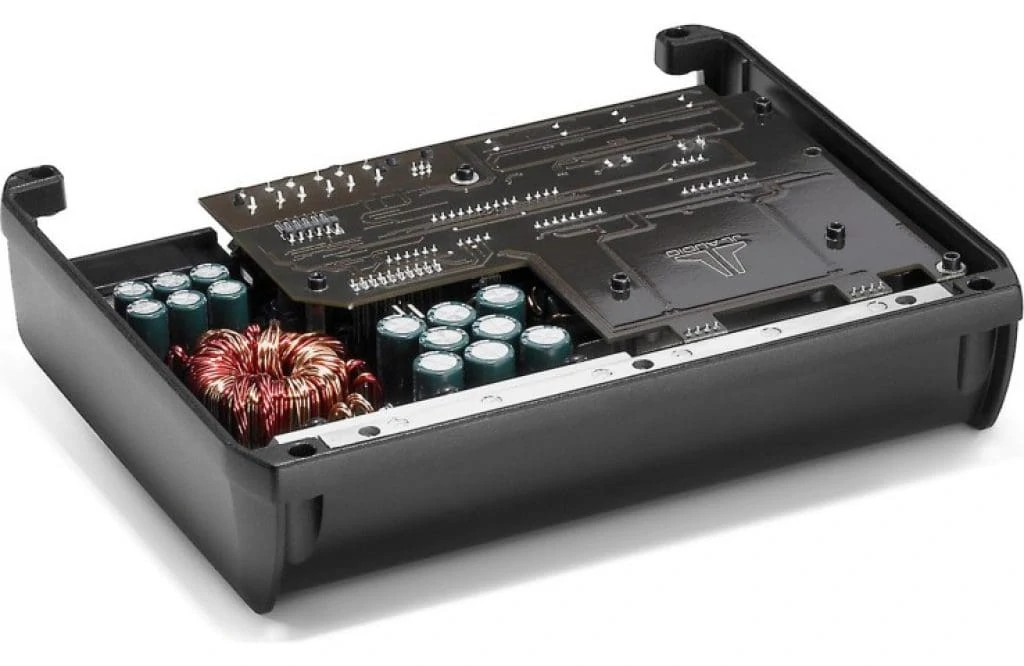
When it comes to car amps, there’s a lot of difference between lower quality and higher quality models.
One big reason is that higher-quality amps pay attention to the design details that lesser amps don’t. In other words, they’re better engineered.
Higher quality amps often have these characteristics:
- Better (and thicker) printed circuit boards (PCBs)
- Surface-mount technology (SMT) components for shorter and smaller paths
- Higher quality components
- Better designs with sound quality in mind
- Low-noise parts and proprietary circuits to improve sound quality
The good news is that it doesn’t have to cost much more money these days to get these kinds of features – many quality amps are very reasonably priced if you shop carefully.
The main difference you’ll discover is that bigger name brands such as JL Audio, Alpine, MTX, Rockford Fosgate, and many more have better experience and resources that they apply to their products.
If you pick just any old car amp there’s no telling what you’ll get! Unfortunately many are made primarily for profit and not for great sound and enjoyment.
RMS power ratings
To be sure you’re getting power from an amp as advertised, you can look for amps using power ratings that follow the Consumer Electronics Association (CEA) – 2006 compliance standards.
The CEA amp power ratings were established to help resolve the problem of so many confusing and misleading car audio specifications that are misleading to buyers.
Essentially buying an amp that features the logo ensures that the manufacturer’s power (and other sound) specifications are accurate and have been proven.
Choosing the right amp power for good sound
For adequate volume and in order to drive you speakers with enough power for dynamic, “punchy” sound, you’ll need enough power.
One reason is that when an amplifier is driven to its limits it is driven to clipping, meaning that the audio waveform the speaker sees is starting to get cut off.
In other words, the amp can’t drive the signal any higher and it begins to distort badly. It’s both a cause of terrible-sounding distortion and potentially damaging to car speakers as well.
To avoid this, pick an amplifier with enough power. For many cases I recommend at least 50W RMS per channel of power. Optionally, 75W RMS gives even more headroom and is still affordable.
What is a class D car amp?
More and more, you’ll find car amplifiers that are built on class D technology.
“Class D” car amplifiers work using a new design which relies on switching technology. They’re much more efficient than traditional car amps – sometimes up to nearly 90% efficient! Older designs were around 50-65% and wasted a significant amount of power as heat. What does this mean? Class D amps are much smaller and run cooler than older designs.
Class D amplifiers use a design based on a switching power supply and signal path. They chop-up the output signal by rapidly switch transistors on and off then restore the original (now amplified) signal back to a smooth sound wave, which then drives the speaker.
By doing so, they greatly reduce the amount of time the transistors are switched on and consuming electric current. This results in a large amount of power that isn’t wasted as opposed to conventional designs.
Originally used only for small home stereo amplifiers, the technology has matured and is now available in some of the best car amps sold today.
More advanced designs even have improved upon the concept and offer better sound quality and dynamic power output than average models offer.
Class AB vs class D amplifiers
Class A/B amps have been the mainstay for decades in the car audio world. The technology is fairly simple, cost-effective, and also can offer very good sound quality. The downside is that they create a lot of heat as they waste power and are larger and heavier than class D amps.
Class AB car amplifiers (often shown as “A/B”, since it’s a combination of 2 types) differ a lot from modern class D types. Unlike newer technology, they’re based on a design principle from as far back as the 1960s or earlier (based on some of the first transistor home stereo amps).
While they’re often found in lower-cost amps and can have good sound quality, they also have some disadvantages:
- Low efficiency: often only 65% efficient
- Generate a lot of heat due to wasted power
- Require a larger and heavier body (heatsink)
As they’re not as efficient as class D designs, they can’t be designed as small and they can be a bit harder to install due to requiring more space.
However, if efficiency and size aren’t a big concern to you, they’re still often a good choice. Because of their tried-and-true design, they can produce very good sound at a good price and there are many choices to choose from.
Standard class A/B amps are often sold as budget models with different manufacturer names.
Class D amplifier sound quality
Class D amps do have a disadvantage, unfortunately. They’re more prone to have lower signal-to-noise (SNR) levels and poorly designed models will have more hiss than better ones.
The higher noise is a by-product of how switching amps work, and it’s a trade-off that comes with the benefit of better efficiency and smaller size, sadly.
There’s no way around it. However, choosing a good model (like the ones I’ve recommended here) will make sure you’re getting one designed to keep noise to a minimum.
Cheaper brands don’t care much about the sound quality like better brands do – and they don’t have the same audio engineering ability that the better choices offer.
I’ve tested both good and bad class D amps and I can tell you that there’s a significant amount of difference when choosing a better class D amp. They sound better, have lower noise, and have better power to offer.
In other words, they’re just all-around better!
★ 5 of the best amps for mids and highs ★
Our top picks
| Image | Product | Details | |
|---|---|---|---|
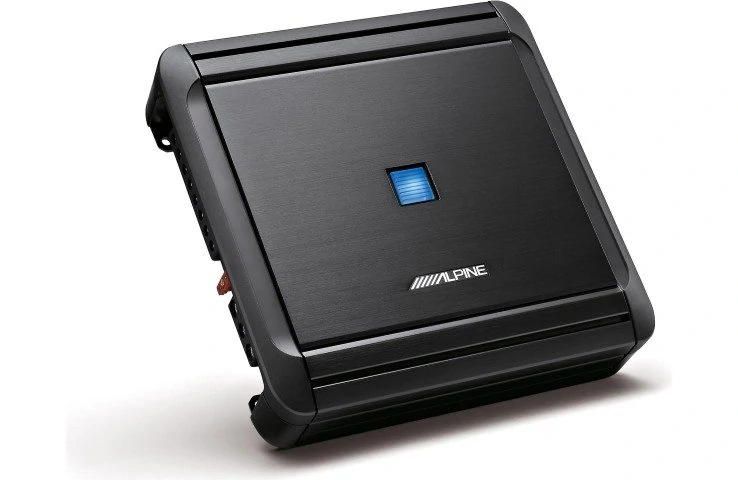 | ★ Our #1 Pick ★Alpine MRV-F300 4 Ch |
| Check on Amazon |
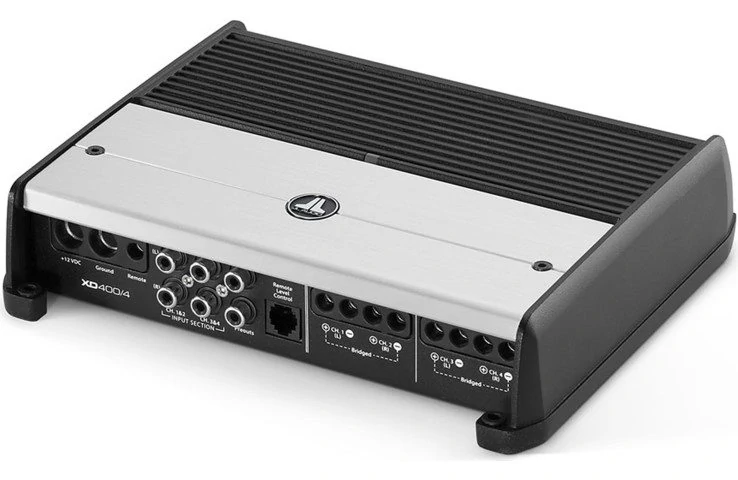 | Superb Sound!JL Audio XD400/4v2 |
| Check on Amazon |
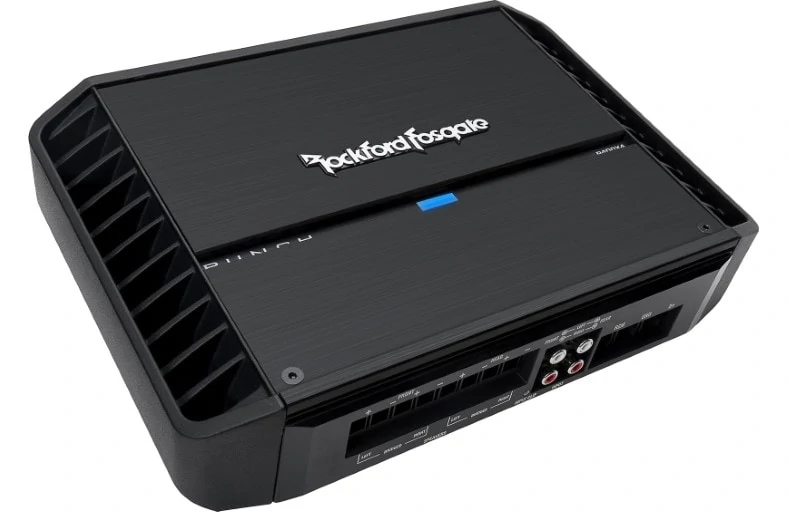 | Rockford Fosgate Punch P400X4 |
| Check on Amazon |
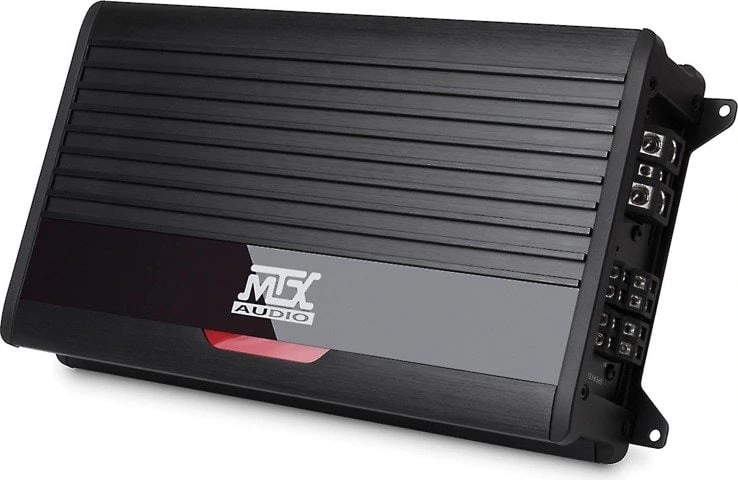 | MTX Audio Thunder 75.4 |
| Check on Amazon |
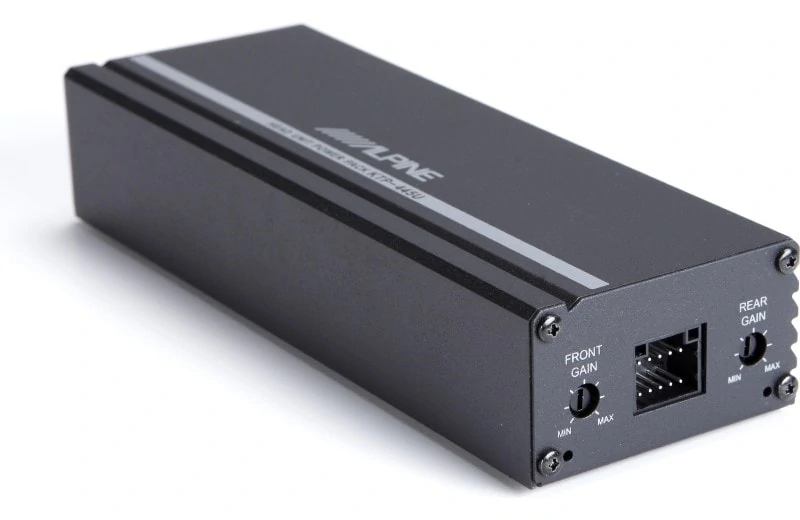 | Ultra compactAlpine KTP-445U 4 Ch |
| Check on Amazon |
Amp reviews and details
1. Alpine MRV-F300 – Great sound, quality, and compact design. Excellent value!
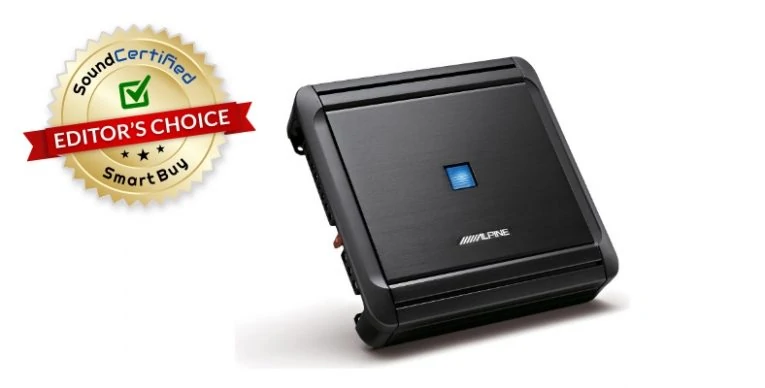
The fantastic compact but powerful MRV-F300 is a great example of an amplifier done right.
One of the most compact 4-channel amps of it kind today, the MRV-F300 puts the lower-end amps to shame. There’s a sleek-looking dark brushed metallic finish on the chassis. The blue backlit power-on light on type adds a nice contrast to the design when your system is powered on.
For a more professional-quality design, end caps are included that cover the connections and help hide wiring when installed. It’s a great touch that helps turn an affordable system into a pro-looking effect.
For about $150 or less you’ll get some great features:
- 50W RMS x 4 @ 4 ohms power
- 75W RMS x 4 @ 2 ohms
- 150W RMS x 2 @ 2 ohms bridged
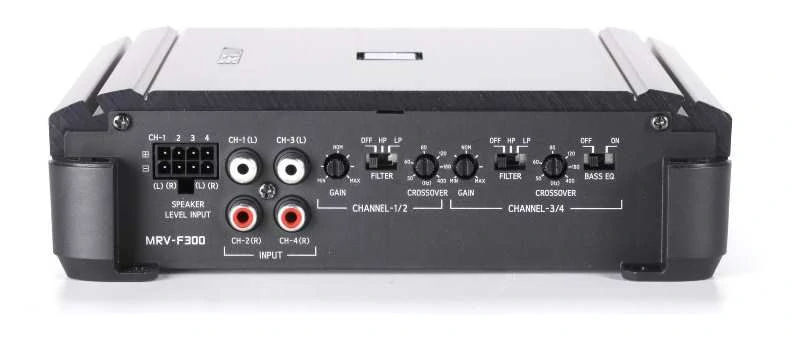
Measuring only 7 7/8″ W x 6.5″ D x 2 3/16″ H (200 x 165 x 55 mm) in size it opens up a whole new range of installation possibilities.
Alpine has once again used their advanced engineering resources to design a super-efficient class D amp that’s amazingly affordable. It’s also one of the best sounding of its kind.
You’ll get great system flexibility, too, especially for using mids and highs in your system:
- 50-400Hz high/low pass adjustable cutoff frequency
- 12dB/octave multi-stage crossover design
- Front and rear crossovers are independent
- Bass EQ boost feature for Ch. 3/4.
I was very impressed with this little amp for its price! As a matter of fact, I wrote a detailed review of the MRV-F300 found here.
It’s a great, affordable, and well-designed amp that’s an excellent compromise between power, size, sound quality, and price.
You simply won’t match the quality from competitors at this price range (around $150).
- Very compact – fits under seats!
- Class D power efficiency
- Good power (50W RMS x 4, 75W RMS x 4)
- Bridgeable (150W RMS x 2 @ 4 Ohms)
- Great sound quality & reduced noise
- Alpine quality design
- One of the most affordable/great value
- Includes end caps for stealth install
- Blue power-on accent light
- High-level speaker inputs
- Adjustable high/low-pass crossovers
- Bass boost on ch. 3/4
- Excellent buyer ratings
- Nice satin brushed metal finish
- CEA-2006 Compliant
- Auto turn-on for speaker-level inputs
- Bass boost is only for ch. 3/4
- Bass boost could be greater (12dB vs 18dB of others)
- No remote level control option
- No RCA pass through jacks
- Bass boost frequency not adjustable
- No auto-sensing turn on for RCA inputs (only speaker level)
I’ve awarded this one the Editor’s Choice for these many great reasons. It’s simply one of the best choices around today!
Don’t pass it up. Head over to see the happy buyer reviews and find out more at Amazon.
2. JL Audio RB XD400/4v2 – Music the way it’s supposed to be heard + modern amp tech & features. Fantastic!
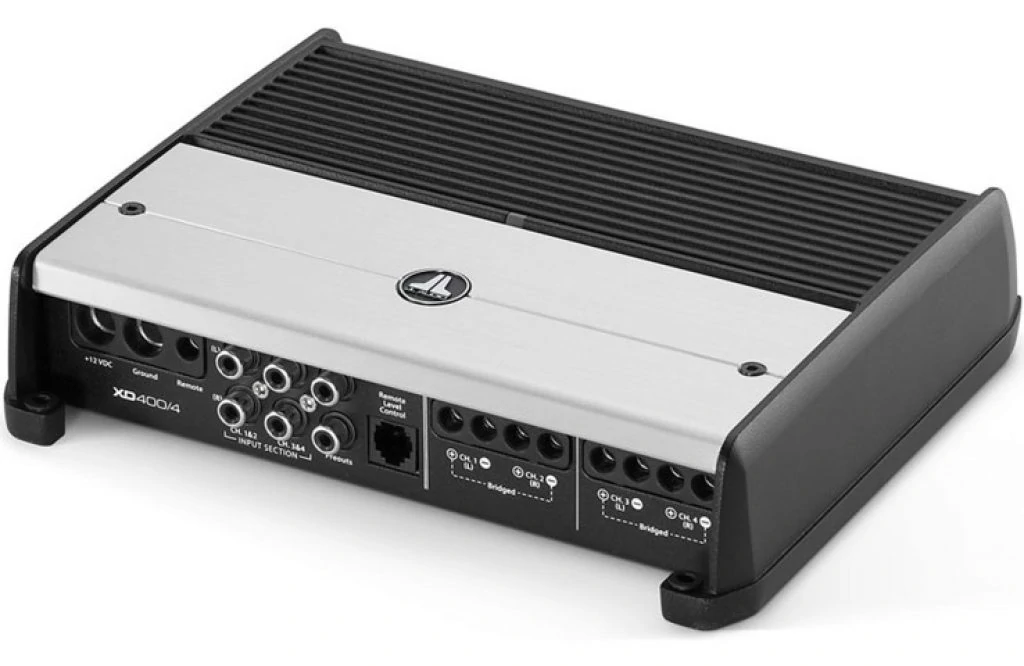
JL Audio has taken the modern class D switching design and upgraded it with their own higher-performance version called NextD.
You’ll get performance both in terms of power and sound quality that’s far above average. NextD uses a faster switching speed than lower-performing competitors do result in power that’s always available.
The audio design and higher-quality circuit board layouts also ensure lower noise and better signal quality, too.
The XD400/4 is simply without comparison when it comes to sound quality and performance. The crossover controls are on top (included cosmetic cover not shown) for easier control access. You’ll need the included hex wrench to connect power and speaker wiring as it uses different connectors for those than most.
You’ll get plenty of power to drive your mids and highs, too:
- 75W RMS x 4 @ 4 Ohms
- 100W RMS x 4 @ 2 Ohms
- Bridged: 200W RMS x 2 @ 4 Ohms
These are under-rated numbers, too! The XD400/4 can actually exceed rated power output by a bit.
It’s a small amp too, measuring only a tiny 8.52 in. x 7.09 in. x 2.05 in. (217 mm x 180 mm x 52 mm). It’s one of the few ultra-compact amps that can accept a 4 gauge power wire.
You’ll get great signal and crossover features too, making it easy to drive the perfect system giving your mids and highs powerful, distortion-free sound:
- Low/high-pass 12dB/octave cutoff frequencies: 50-500Hz adjustable
- Pass-through RCA jacks for 2nd amp connection
- 2/4 ch. input adapter switch
- Very compact – fits under seats!
- Class D power efficiency
- 2/4 ch. input switch
- Great power (75W RMS x 4, 100W RMS x 4)
- Bridgeable (200W RMS x 2 @ 4 Ohms)
- Fantastic sound quality
- Advanced class D (NextD) technology
- Top-of-class quality and power
- Includes control cover to nice install
- Green power-on accent light
- High-level speaker inputs
- Adjustable high/low-pass crossovers
- Optional remote level (HD-RLC)
- Excellent buyer ratings
- Brushed aluminum and black powder coating finish
- CEA-2006 Compliant
- 3 remote-on methods (auto-sensing)
- 2 RCA pass-through jacks
- 4 gauge wire capable
- Optional remote sold separately
- No bass boost feature
- Speaker-level inputs require RCA splicing
- Expensive
If you’re wanting one of the most powerful, smallest, and best-sounding amps available today, look no further.
It’s sold many places but No products found.
3. Rockford Fosgate Punch P400X4 – Great sound in a small package – plus cool set-up features built in.
Looking for a compromise between price, size, and features? The Rockford Fosgate Punch P400X4 is one of the best and most refined versions of classic A/B audio technology available today.
Unlike other class A/B 4 channel amps, Rockford Fosgate has used their proprietary Trans-ANA circuitry design to not only reduce noise but to take sound quality a step further.
It’s a well-designed amp that I’m impressed with – the build and engineering quality really shows. Unlike competitors, Rockford’s design takes up less space and is designed to be able to handle stressful power situations with ease.
The Punch PX400/4 features a microprocessor-based heat management system that allows it to safely keep the amp running instead of shutting off like lesser amps.
That means during really hot days or high-power maximum listening levels you’ll be ok – the music won’t stop. Instead the system will monitor and maintain a lower power output to keep the heat at a safe level.
One thing I really like is how the company was able to fit so much technology into a package only 11-1/8″ x 2-7/16″ x 8-13/16″ in size.
A great choice for mids and highs, the P400X4 is an excellent choice for your money. It’s a CEA-2006 compliant rated amp so you know the specs are honest and it’ll deliver as promised. The signal-to-noise ratio (SNR) at the rated power output is a fantastic 105dB! It’s unique in that not only do you get flexible crossover features but additional set-up features to help you set the gain and input level settings during installation.
You’ll get plenty of power to run clear, loud, and enjoying quality music from component speaker mids and highs:
- 50W RMS x 4 @ 4 ohms
- 100W RMS x 4 @ 2 ohms
- 200W RMS x 2 @ 4 ohms
You’ll get some great crossover features, too:
- Fully adjustable high/low-pass frequency levels: 50-250Hz
- Optional adjustable Punch EQ w/ up to 18dB boost @ 50Hz or 12.5KHz
- 2/4 channel input source switch
- Input level control allows speaker-level inputs
There’s also an optional Punch EQ remote control for easy dashboard bass level adjustments while driving.
Unfortunately, I did find one issue with the amp, and that is that it doesn’t offer speaker-level inputs so you’ll need an RCA line level adapter for that. However, a good one that will work with the amp is only around $15-20 or so.
Special built-in installation features
What helps make the P400X4 so different is the C.L.E.A.N. gain setup system built into it. With it, setup is easier and you’ll be sure you get the most from your amp and head unit!
Working with the including test tone CD (or test track MP3s can be used), the amp monitors and indicates input signal levels so you can adjust the gain for maximum output and minimal noise.
That’s a really cool advantage to have as it takes the guesswork and frustration out of trying to set up your system. It also means you won’t need to buy additional test equipment or accessories, too.
- Compact size – fits under some seats
- C.L.E.A.N. setup features & test CD
- Punch remote option
- Input clipping indicators
- Class A/B sound quality
- 2/4 channel input switch
- Good power (50W RMS x 4, 100W RMS x 4)
- Bridgeable (200W RMS x 2 @ 4 Ohms)
- Great sound quality & reduced noise
- Rockford Fosgate quality
- Blue power-on accent light
- Accepts higher-voltage signal (12V max)
- Adjustable high/low-pass crossovers
- Punch EQ boost adjustable (+18dB max)
- Excellent buyer ratings
- Nice black brushed metal finish
- Muted turn-on
- No speaker-level inputs
- Punch level control not included
- No auto-on remote feature
- No RCA pass through jacks
- Less efficient than class D models
- A bit larger in size than class D
As a great-sounding, well-made, and wonderful little amp you’ll love I highly recommend it!
Don’t waste any more time searching or shopping. Go find out today why it's one of the best-rated amps for highs and mids at Amazon.
4. MTX Audio Thunder 75.4 – Great power, sound, and affordability in a compact size.
Wanting excellent sound but need more power? I totally understand! In my own system, I use two 4-channel amps with 75W RMS per channel for crisp and detailed sound that won’t bottom out.
The MTX Audio Thunder 75.4 4-channel amp has exactly what you need for the same great sound.
The Thunder 75.4 gives you legendary MTX Audio design quality, great power and sound, and reliability, too. It’s also an under-rated amp and can slightly exceed the rated power specs.
And yet’s it’s still affordable, too, at around $200.
You’ll get plenty of power to drive component speaker mids or highs:
- 75W RMS x 4 @ 4 ohms
- 100W RMS x 4 @ 2 ohms
- 200W RMS x 2 @ 4 ohms
Using tiny surface mount technology (SMT) components, MTX designs their amplifiers not for bottom-dollar pricing like the competition does but instead for the best performance, signal quality, and value for your dollar.
In addition to a compact size that’s easy to install, you’ll also get a lower noise floor and excellent resistance to vibration. DC offset, thermal, and short-circuit protection are built in as well to keep your investment protected in case a problem comes up.
Based on classic and proven class A/B audio technology, MTX has taken the traditional design a bit further by using higher-quality audio path components as well as reducing signal path lengths to keep noise minimized.
Having used and installed MTX many times in my installation career I can tell you that they’re some of the best and definitely worth the money!
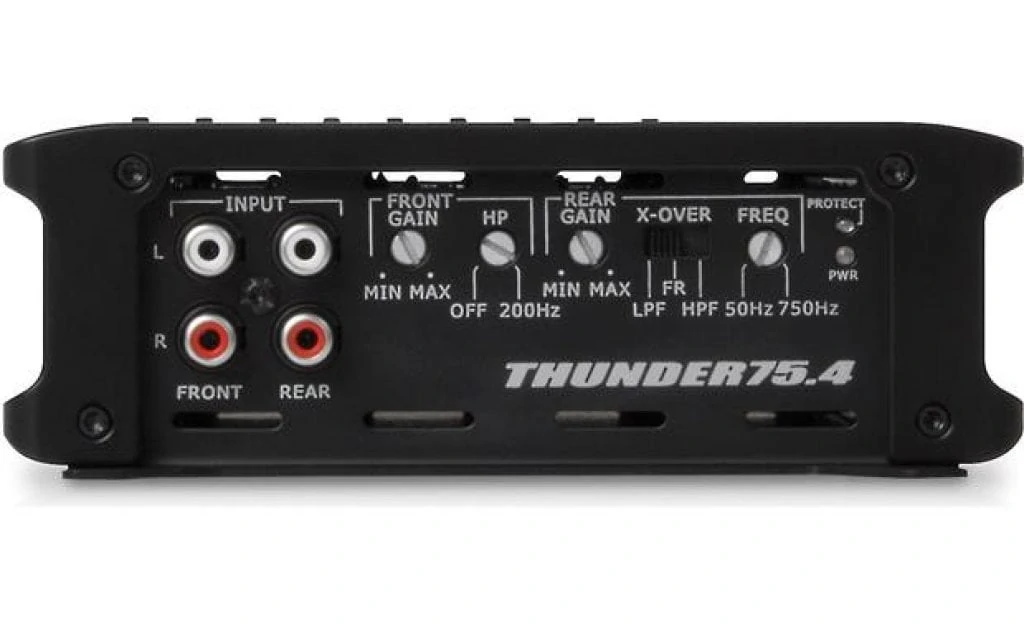
You’ll get some great crossover features as well – perfect for a custom system running separate mids and highs or even a 2-way front stage with a rear subwoofer.
Crossover specs include:
- Front low/high-pass: 12dB/octave, 0-200Hz adjustable
- Rear low/high-pass: 12dB/octave, 0-750Hz adjustable
- Rear channels: Full-range, low-pass, or high-pass
The power connection block allows using 4 gauge wire, which is something I haven’t found on a lot of amps this size.
Sadly, to my disappointment, there’s no speaker-level input support. However, line-level adapters are relatively inexpensive, so that’s more of an inconvenience and definitely not a show-stopper.
- Compact size – fits under many seats
- Class A/B sound quality
- Great power (75W RMS x 4, 100W RMS x 4)
- Bridgeable (175W RMS x 2 @ 4 Ohms)
- Adjustable crossovers (hi/low 0-200Hz, 0-750Hz)
- Great sound quality
- Reduced noise design
- MTX design quality & reliability
- Adjustable high/low-pass crossovers
- Great buyer feedback
- 5V capable RCA inputs
- CEA-2006 Compliant
- Includes MTX test certificate
- Soft turn-on
- No speaker-level inputs
- No remote level option
- No auto-on remote feature
- No RCA pass through jacks
- Less efficient than class D models
- No bass boost feature
Unless you have the most extreme demands, you’ll love this one. It’s a great sounding amp with fantastic power and it’s small enough to fit in many vehicle installations.
Check it out! Find out why it's a favorite among smart amp shoppers over at Amazon.
5. Alpine KTP-445U Ultra-compact – Great power powering mids and highs from a tiny size!
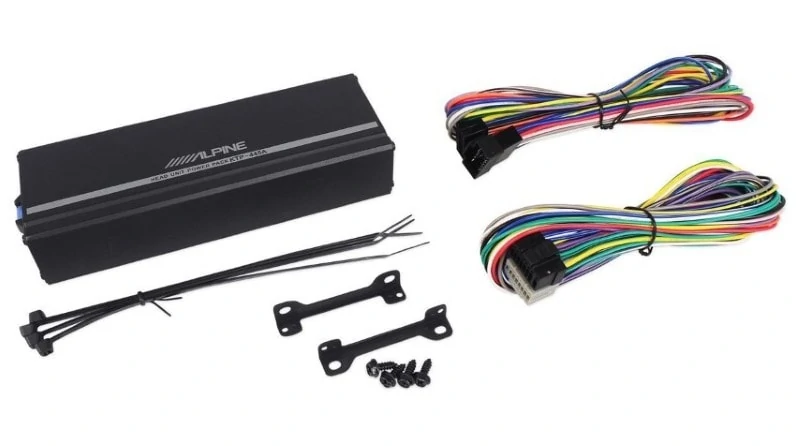
It’s a fantastic installation option for both aftermarket or factory stereo head units for everything from car and trucks to boats or motorcycles.
Perfect for driving mids and highs with clean, high-efficiency power, it’s truly a stand-out marvel of modern Alpine design technology.
As seen in my detailed review of the KTP-445U here, it’s an example of some of the best engineering and sound quality you’ll get in a super-small package.
Measuring a tiny 7 7/16 x 1.5 x 2.5″ (189 x 38.2 x 64.5 mm), I’m almost in shock at how something so small can deliver so much. Despite the incredible size advantage you’ll get plenty of power.
The KTP-445U can deliver:
- 45W RMS x 4 @ 4 or 2 Ohms
- 90W RMS x 2 @ 2 Ohms
Despite that, it runs perfectly cool and draws nearly 1/2 as much electrical current as traditional amps. The modern class D design (with Alpine’s own proprietary touches) is one of the most efficient and best-sounding in its size and price class.
It’s so efficient that for many installations you can connect it directly to existing radio power wiring instead of installing a separate amp power wire!
Unlike other class D mini-amps you can drive 2 Ohm speakers as well.
One of the smallest car amps in the world today, the KTP-445U is in a league of its own. At only 7 7/16 x 1.5 x 2.5″ (189 x 38.2 x 64.5 mm) in size, it delivers impressive sound and power that you won’t get from most competitors. It’s so small it’s about the size of a laptop power converter, yet delivers enough power & flexibility to drive mids and highs for a whole system!
One feature I really like is that it’s “universal” and designed to be easy to install. Both RCA and speaker-level inputs are provided, making it a great match for factory systems too.
Don’t have front and rear RCA outputs on your head unit? No problem. Use the 2/4 channel input switch to take advantage of the built-in adapter and get 2 more channels immediately.
Alpine uses proprietary design and electronics technology to minimize noise levels and maximize sound quality that delivers a crisp, lively sound that’s good to the ear.
Despite being so small, I think it’s a great-sounding amplifier you’ll love and I really appreciate how much easier it makes installation.
At near $150 or so, it’s not the absolute cheapest out there, but for the sound quality, installation ease, flexibility, and enjoyment it’s great and definitely worth the money!
- Ultra-compact – fits in dash or nearly anywhere!
- Excellent for factory system upgrade
- High-efficiency class D design
- 2/4 channel input switch
- Good power (45W RMS x 4 @ 4 or 2 Ohms)
- Bridgeable (90W RMS x 2 @ 4 Ohms)
- High-pass 60/80/120Hz crossovers
- Great sound quality & reduced noise
- Easy to install
- Great wiring and signal harnesses (universal)
- Accepts higher-voltage signal (12V max)
- Excellent buyer ratings
- Nice brushed metal finish
- Handy mounting tabs
- Includes basic mounting accessories
- CEA-2006 Compliant
- Auto turn-on for speaker level inputs
- No low-pass crossovers
- Not suitable for driving woofers
- No remote volume option
- No auto-on remote feature
- Auto turn-on won’t work for RCA inputs
- High-pass crossover not adjustable – fixed to 4 pos.
I highly recommend this one if you want an amp that can fit nearly anywhere.
Have a look to see why no other ultra-compact amp at Amazon can compare.
